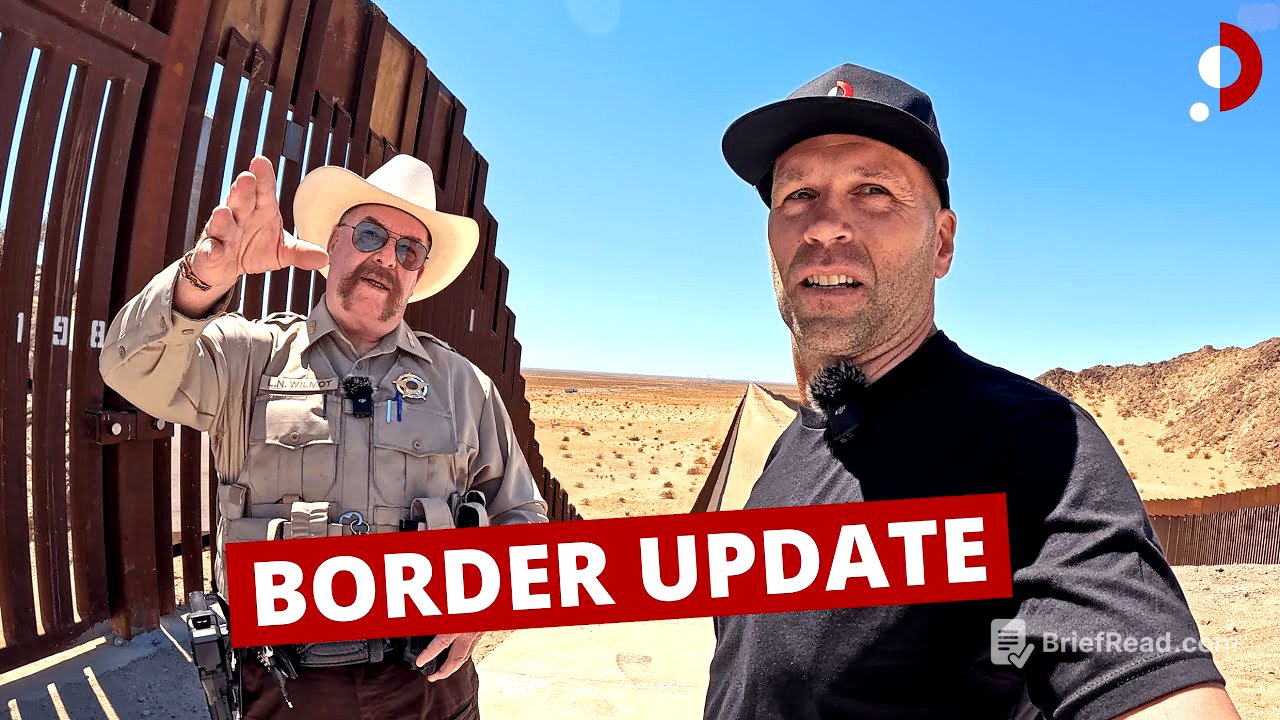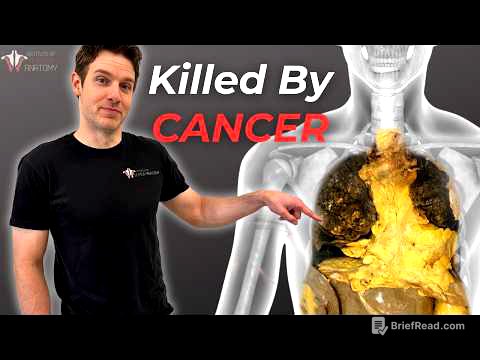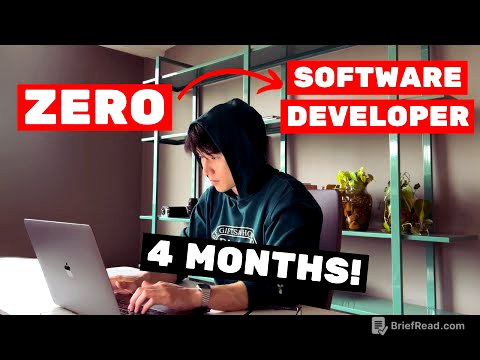TLDR;
This video provides an update on the situation at the Yuma, Arizona border, two years after Peter Santenello's initial visit. Sheriff Trivette discusses the changes in border security, the impact of immigration policies on the local community, and the perspectives of law enforcement and healthcare professionals. Key points include:
- A significant decrease in illegal border crossings due to policy changes and increased border patrol presence.
- The economic impact of immigration on local services like hospitals and the strain on law enforcement resources.
- The role of cartels in human smuggling and the challenges they pose to border security.
- The importance of separating political ideologies from public safety and law enforcement.
Intro [0:54]
Peter Santenello revisits Yuma, Arizona, with Sheriff Trivette to assess the changes at the border since their last video two years ago. The primary focus is on the shift in border security and its effects on the local community. The sheriff notes a significant decrease in people dying in the desert, attributing it to changes in border policies.
Border Wall and Patrol [2:40]
The discussion covers the construction of the border wall, including sections built under both the Trump and Biden administrations. The current wall design, filled with concrete, is more difficult to breach than previous fencing. There's a noticeable increase in Border Patrol agents, contributing to a different atmosphere compared to the earlier chaotic situation.
Impact of Illegal Immigration [5:48]
The sheriff emphasizes that the issue is not about being anti-immigrant but about addressing the chaos caused by illegal immigration. The influx strained local resources, such as hospitals and agricultural lands. The focus is on preventing victimization of migrants by criminal elements and ensuring food safety for the community.
Cartel Activity and Smuggling [6:53]
With fewer people crossing, cartels are experiencing financial setbacks and are resorting to recruiting juveniles to transport migrants into cities. Border Patrol's increased presence helps intercept these activities. The discussion distinguishes between "give-ups" (those seeking asylum) and "gotaways" (those avoiding detection), noting that the "give-up" strategy has been largely shut down.
Tribal Lands and Border Cleanup [13:01]
The construction of the wall is complicated by tribal lands, which are considered sacred. The Cocopah tribe's access to the river is part of their history. Increased media attention and nonprofit efforts have led to significant cleanup of litter and pharmaceuticals along the river, benefiting both the tribe and local wildlife.
Law Enforcement and Immigration [14:45]
The sheriff expresses relief that law enforcement can now focus on improving the community's quality of life rather than dealing with immigration issues, which are the federal government's responsibility. Local law enforcement focuses on curbing criminal activities like rapes, robberies, and homicides, which affect both migrants and Border Patrol agents.
Messaging and Policy Changes [16:07]
Policy changes are attributed to the messaging from different administrations. Clear communication about border security and consequences can deter illegal crossings. The sheriff highlights the frustration of knowing what works in law enforcement but being constrained by changing policies.
Financial Impact of Immigration [17:14]
The financial burden of mass immigration is discussed, including the high costs of welfare, assistance, and housing for immigrants. The sheriff mentions that in one year, roughly $246 billion was spent on welfare and assistance to immigrants. The cost of maintaining tent facilities for processing migrants was exorbitant, with each tent costing half a million dollars a day.
Sheriff's Raptor and Law Enforcement [20:08]
The sheriff clarifies that the Raptor truck was donated for a program to educate other sheriffs and elected officials about the realities of the border. The vehicle's reliability is essential for deputies patrolling the harsh desert environment, ensuring their safety and ability to respond to emergencies.
Ground News Sponsor [22:39]
The video includes a sponsorship message for Ground News, an app and website that helps users parse through biased media by showing how the same story is covered from different political perspectives.
Meeting with Hector, Retired Border Patrol [24:01]
Peter meets with Hector, a recently retired Customs and Border Protection agent, to get his perspective on the border situation. Hector explains that he retired early because he felt the agency had shifted from enforcement to being part of a smuggling organization.
Shift in Border Patrol Operations [25:55]
Hector describes how Border Patrol operations changed, with resources being diverted from securing the border to processing migrants. This led to a lack of proper field training for agents and a situation where illegal aliens dictated operations.
Cartel Tactics and Border Control [28:49]
Cartels use tactics such as staging "give-ups" in remote areas to draw resources away from urban areas where they smuggle drugs and engage in sex trafficking. Hector emphasizes that during his time, Border Patrol felt like they had no control over the border.
Motivations Behind Border Policies [30:10]
Hector believes that the border policies were intentionally designed to be the way they were, rather than being the result of incompetence. He apologizes to the American people for the consequences of these policies, including increased crime and the strain on local communities.
Immigration and Crime [32:14]
While acknowledging that most immigrants are good people seeking a better life, Hector points out that the scale of illegal immigration brings in a criminal element. He argues that any crime committed by someone who shouldn't be in the country is outrageous.
Legal Immigration and Vetting [33:39]
Hector highlights the beauty of legal immigration, where people come to work and contribute to society. He suggests that the federal government should set up a system for more work visas and paths to citizenship with solid vetting processes.
Cartel Control and Plazas [35:38]
The cartels control the border and charge migrants thousands of dollars to cross. They operate through "plazas," which are territories controlled by plaza bosses who enforce the cartel's rules.
Cartel's Shift to Drugs [36:49]
With illegal crossings down, cartels are likely shifting back to drug smuggling, using tunnels, drones, and other methods. Border Patrol agents are now able to focus on law enforcement rather than humanitarian efforts.
Vetting and Asylum Claims [38:02]
Hector reveals that the claim that everyone was being vetted was false, as background checks were limited to what migrants verbally provided. He also points out that many asylum claims were not legitimate, as migrants were often coached by cartels on how to game the system.
Lost Unaccompanied Children [39:57]
Under previous administrations, rapid DNA testing was conducted to verify family units, but this practice stopped. As a result, hundreds of thousands of unaccompanied children were lost within the system and likely victimized.
Political Manipulation and Public Safety [40:25]
Hector emphasizes that the border problem should not be a political issue but a matter of public safety. He criticizes politicians for pushing political ideologies into public safety and for not consulting with those who are impacted by their laws.
Mexican Side of the Wall [44:52]
The discussion moves to the Mexican side of the wall, where the sheriff explains that fencing is placed in different areas due to floodplain concerns. He notes that the Hispanic heritage is about hard work and dedication to family, which aligns more with conservative values.
Political Shifts in Yuma County [46:20]
Yuma County, traditionally blue, has shifted to red, driven by Latino voters who value hard work and being left alone. The sheriff emphasizes that he votes for policies, not parties, and values the character of a person over race or religion.
Cartel Activity Under the Bridge [49:23]
The sheriff recalls how the cartel was letting migrants out under the bridge right up until the election results were announced. The cartel would videotape people crossing to prove to their families that they had made it to the US, demanding payment.
Impact of Policy Changes [51:19]
After the election, apprehensions dropped dramatically, indicating the impact of policy changes. The sheriff notes that Border Patrol is gradually returning to its core mission of border security.
Border Patrol and Public Perception [52:18]
A Border Patrol agent expresses that things are better now, but it will take time for the agency to fully recover. She is cautious about speaking on camera, fearing that it could impact her career.
Cartel Cloning and Port of Entry [54:06]
The cartels clone construction company trucks to blend in with legitimate activity near the port of entry. The San Luis port of entry is always busy, with people crossing for work, family visits, and medical services.
Border Community and Healthcare [54:50]
Yuma's population increases significantly during the winter due to agriculture and winter visitors. Many people cross the border to Algodones for medical and dental work. The sheriff notes that 800 kids cross the border daily to attend school in the US.
Impact on Local Hospital [56:00]
The influx of migrants, particularly pregnant women, strained the local hospital, resulting in $24 million in unpaid charges in a six-month period. The hospital provides care to everyone regardless of their ability to pay, but this puts a financial strain on the community.
Border Patrol and Hospital Costs [56:47]
If migrants are brought to the hospital by Border Patrol, the federal government pays the bill. However, if they walk to the hospital on their own, the community foots the bill.
Mexican Highway and Border Technology [57:19]
Mexican Highway 2 runs along the other side of the fence. Border Patrol uses cameras and sensors to monitor activity in the area.
Cooperation with Mexican Authorities [57:51]
The sheriff recounts instances where they assisted Mexican authorities in recovering drowning victims, noting that the families were more appreciative than people often are in the US. He emphasizes that border communities share similar concerns about cartel activity.
Border Wall Construction [59:30]
The border wall construction stopped when Biden came into office, but some gaps are being filled. The sheriff points out that Biden did put up some wall, particularly near agricultural areas, but this was not widely reported.
Deaths in the Desert [1:02:31]
In 2022, 70 people died in the desert while attempting to cross the border. The area is also a bombing range, posing additional dangers to migrants.
Media Narrative and Border Reality [1:03:37]
The sheriff laments that media outlets often spin stories to fit their narrative, rather than accurately reporting the facts. He recounts an instance where a New York Times journalist spent a day with him but only wrote a small paragraph about the border impacts.
Mayorkas and Border Security [1:05:39]
The sheriff criticizes Secretary Mayorkas for not implementing a 16-point plan for border security and for removing Sheriff Daniels from the Homeland Security Council. He recounts telling Mayorkas that he was "full of sh*t" for not following through on his promises.
Mexican Government and Border Security [1:08:01]
The Mexican government has stepped up its efforts to protect the border, sending law enforcement and military to the area. The Mexican military is conducting inbound checks from the US into Mexico, targeting guns, ammo, and money.
Corruption and Law Enforcement [1:09:53]
The sheriff acknowledges that corruption exists in law enforcement but emphasizes that they police themselves and hold those accountable who violate their code of honor, integrity, and ethics.
Trust in Law Enforcement [1:11:39]
The sheriff pushes back against the narrative that people in the country illegally won't report crimes due to a lack of trust in law enforcement. He explains that there are routes to get victims B visas to stay in the US and address the crimes committed against them.
Impact on Local Hospital Revisited [1:13:30]
The video shifts to a discussion with Michelle from Onvida Medical Center (formerly YRMC) about the impacts of border policies on the hospital. In 2022, the hospital saw a large influx of patients coming over the border, resulting in $26 million in unpaid charges.
Hospital Operations and Patient Care [1:15:26]
The hospital's focus is to provide the same level of care for every person, regardless of their ability to pay. However, the large number of unpaid charges is not sustainable for the organization.
Challenges and Solutions [1:16:58]
During peak times, the hospital had to delay scheduled deliveries and find hotels for patients who had nowhere to go. Now that most patients are coming in under Border Patrol custody, the hospital is getting reimbursed for emergency care.
Healthcare in America [1:18:38]
Michelle emphasizes that everyone gets healthcare in America, regardless of their insurance status or citizenship. The most acutely injured are treated first.
Community Concerns and Hospital Finances [1:19:23]
The influx of migrants angered some locals, as it pushed down the priority of their care. The hospital needs to maintain certain profits to pay its nurses and keep the lights on, and the unpaid charges risked the operation.
Current Hospital Situation [1:21:38]
In the last six months, the hospital has incurred $1.5 million in charges for 76 patients coming over the border, but they project to receive $181,000 in reimbursement from the federal government.
Conclusion [1:23:00]
The sheriff and Peter conclude the video, hoping that it provided a true-life update on the border situation. They thank the viewers for joining them on the journey and emphasize the importance of separating politics from public safety.









